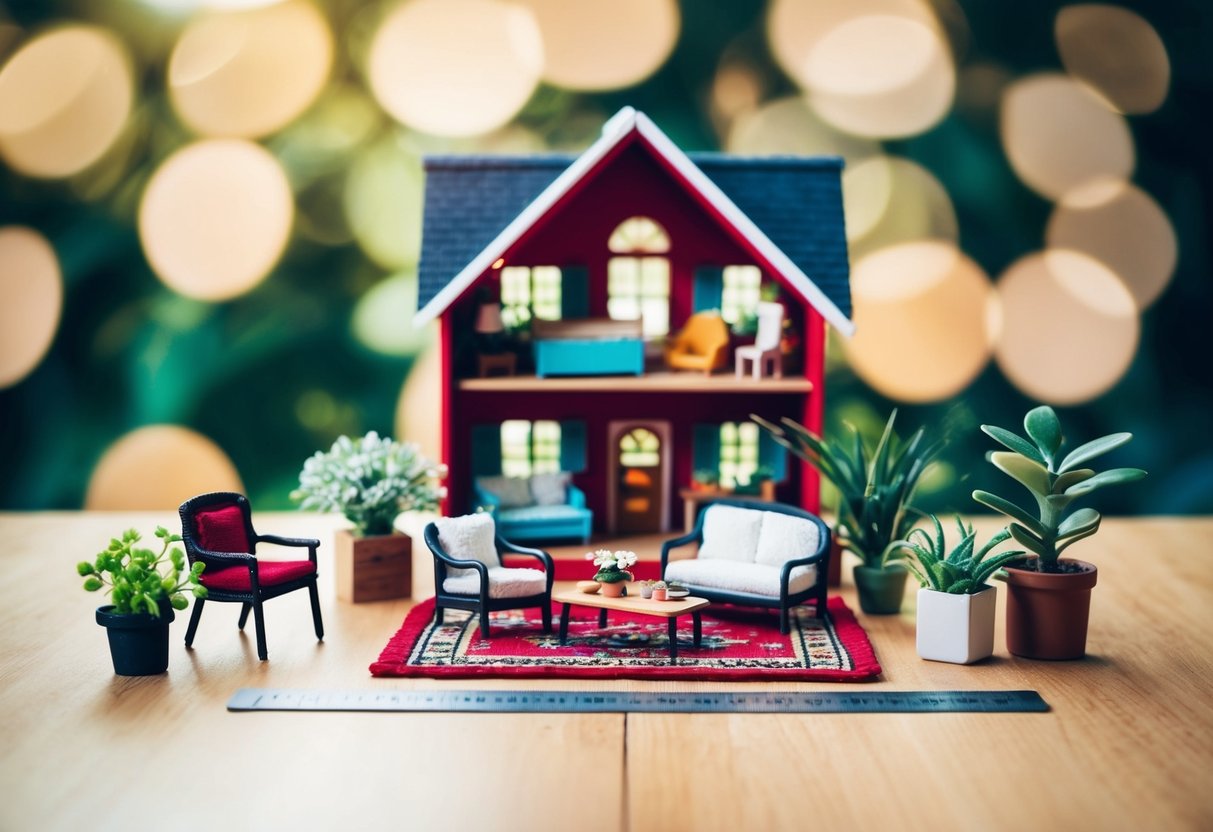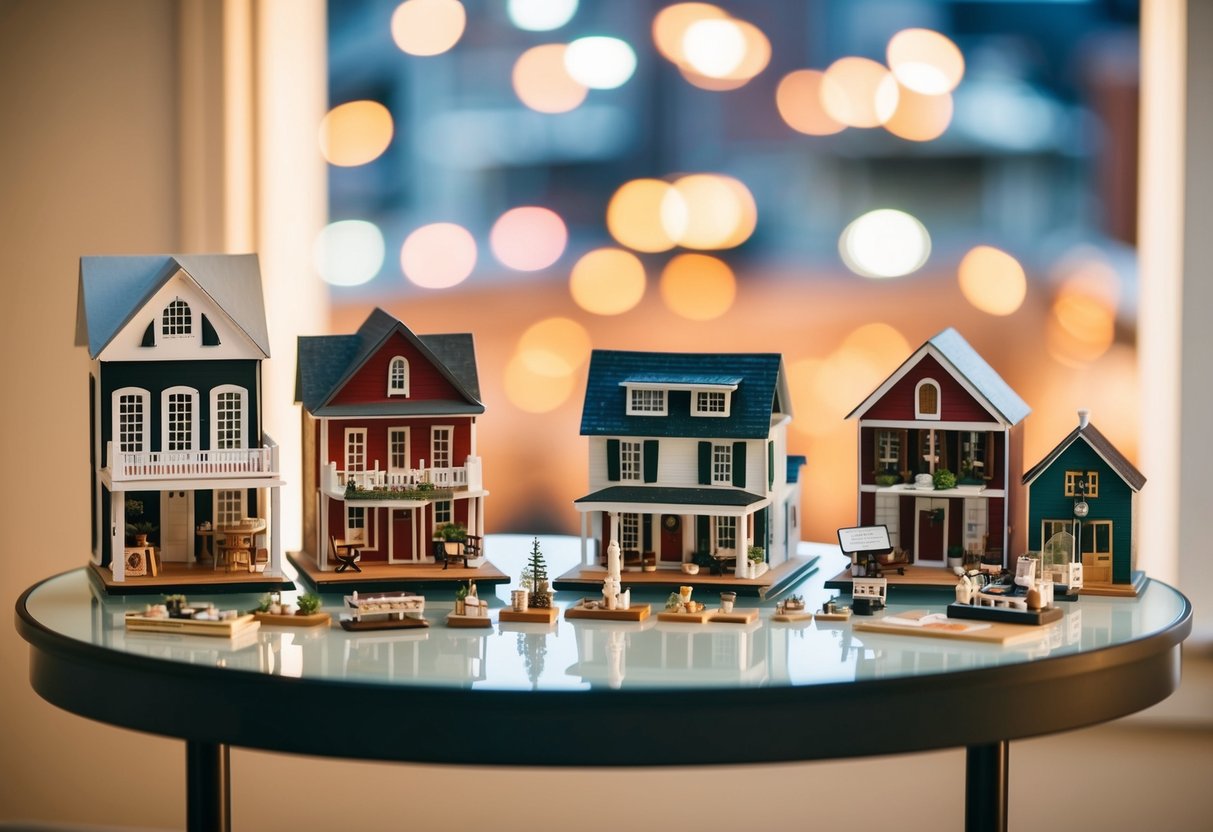A Friendly Guide to Miniature Sizing
Choosing the right scale for your dolls’ house and accessories can be a fun but tricky task. It’s like picking the perfect outfit – you want everything to fit just right! The scale you pick will decide how big or small your tiny world will be.
 There are different scales to choose from, each with its own charm. The most popular scale for dolls’ houses is 1:12, which means one inch in the miniature world equals one foot in the real world. This scale lets you add lots of cute details to your tiny rooms.
There are different scales to choose from, each with its own charm. The most popular scale for dolls’ houses is 1:12, which means one inch in the miniature world equals one foot in the real world. This scale lets you add lots of cute details to your tiny rooms.
If you fancy a bigger dolls’ house, you might like the 1:6 scale. It’s great for fashion dolls like Barbie. For those who want a super tiny house, the 1:24 or 1:48 scales are lovely choices. They’re perfect if you don’t have much space but still want to create a magical mini world.
Understanding Dollhouse Scales
 Dollhouse scales help create miniature worlds that look real. They make sure everything fits together just right. Let’s explore how scales work and why they matter.
Dollhouse scales help create miniature worlds that look real. They make sure everything fits together just right. Let’s explore how scales work and why they matter.
The Basics of Scale and Size
Scale tells us how big or small a dollhouse is compared to real life. The most common scale is 1:12. This means 1 inch in the dollhouse equals 12 inches in real life.
Here are some popular scales:
- 1:6 scale: Barbie-sized dolls
- 1:12 scale: Standard dollhouses
- 1:24 scale: Half-inch scale
- 1:48 scale: Quarter-inch scale
- 1:144 scale: Tiny dollhouses
Each scale offers a different level of detail. Larger scales like 1:6 show more, while smaller scales like 1:144 are great for making whole towns.
Comparing Different Scales
Different scales create unique looks for dollhouses. A 1:12 scale house might be 60 cm tall, perfect for lots of detail. A 1:48 scale house could be just 15 cm tall, good for small spaces.
Here’s a quick comparison:
| Scale | Height of a 6-foot person | Use |
|---|---|---|
| 1:6 | 30 cm | Fashion dolls |
| 1:12 | 15 cm | Standard dollhouses |
| 1:24 | 7.5 cm | Space-saving dollhouses |
| 1:48 | 3.75 cm | Miniature scenes |
Smaller scales like 1:144 are fun for making tiny worlds that fit in your hand.
The Importance of Scale Consistency
Using the same scale for everything in your dollhouse is key. If you mix scales, things won’t look right. A 1:12 scale doll would look giant next to 1:24 scale furniture!
Sticking to one scale helps:
- Make rooms look real
- Fit furniture properly
- Create a believable mini world
When buying dollhouse items, always check the scale. This keeps your dollhouse looking neat and tidy. It’s also fun to collect items all in the same scale over time.
Choosing a Scale for Your Dollhouse
 Picking the right scale is key for a great dollhouse project. It affects how much detail you can add and what items will fit. Let’s look at what to think about when choosing a scale.
Picking the right scale is key for a great dollhouse project. It affects how much detail you can add and what items will fit. Let’s look at what to think about when choosing a scale.
Factors to Consider When Choosing a Scale
Space is a big deal when picking a scale. A 1:12 scale dollhouse needs more room than a 1:24 scale one. Think about where you’ll put your dollhouse.
Your eyesight matters too. Smaller scales like 1:48 have tiny details that can be hard to see. If you want to see every little thing, go for a bigger scale.
Budget is another thing to think about. Larger scales often cost more because they need bigger items. Smaller scales might save you money.
Time is also key. Bigger scales take longer to build and fill with furniture. If you’re short on time, a smaller scale might be better.
Popular Scales for Different Types of Collectors
1:12 scale is a favourite for many collectors. It’s big enough to show lots of detail but not too huge. Many shops sell items in this scale.
1:24 scale, or half-scale, is great for those with less space. It’s still big enough to add nice details.
1:48 scale, or quarter-scale, is perfect for tiny spaces. It’s a hit with collectors who like a challenge.
Playscale, which fits dolls like Barbie, is fun for kids and adults alike. It’s bigger than most dollhouse scales.
Here’s a quick look at popular scales:
| Scale | Size | Good for |
|---|---|---|
| 1:12 | 1 inch = 1 foot | Lots of detail |
| 1:24 | 1/2 inch = 1 foot | Saving space |
| 1:48 | 1/4 inch = 1 foot | Tiny homes |
| Playscale | Varies | Playing with dolls |
Customising for Unique Dollhouse Projects
Some folks like to mix scales in one project. They might use a bigger scale for main rooms and smaller scales for attics or far-away views.
You can also make your own scale. This is great for odd-sized spaces or special ideas. Just make sure you can find or make items to fit.
For really unique projects, try using found objects. A tin can could be a room in a tiny scale. A shoe box could be a whole house in a bigger scale.
Remember, there’s no wrong choice. Pick the scale that makes you happy and fits your project best.
Accessorising Your Dollhouse
 Picking the right accessories brings your dollhouse to life. The scale and style of items you choose can make a big difference in how your miniature world looks and feels.
Picking the right accessories brings your dollhouse to life. The scale and style of items you choose can make a big difference in how your miniature world looks and feels.
Finding the Right Miniatures and Accessories
Start by looking for miniatures that match your dollhouse scale. For 1:12 scale houses, seek out dollhouse miniatures labelled as “one inch scale”. Quarter-scale (1:48) and half-scale (1:24) miniatures work well for smaller houses.
Many brands offer detailed miniatures:
- Calico Critters and Sylvanian Families (1:24 scale)
- Plan Toys (various scales)
- Breyer (1:9 scale for horse accessories)
- Lundby dollhouses (1:18 scale)
Don’t forget about action figures and diecast models. They can add fun touches to your scenes. Just make sure they fit the size of your house.
Look for tiny versions of everyday items:
- Furniture
- Kitchen tools
- Books
- Plants
- Rugs
These small details make your dollhouse feel like a real home.
Creating a Cohesive Look with Accessories
Choose a theme or time period for your dollhouse. This helps you pick accessories that go well together. For example, a Victorian-style house might have:
- Fancy lace curtains
- Ornate picture frames
- Delicate tea sets
A modern dollhouse could feature:
- Tiny laptops
- Sleek furniture
- Miniature houseplants
Mix and match accessories from different makers, but keep the scale consistent. This creates a more realistic look.
Add personal touches with handmade items. You can craft tiny pillows, paint mini artwork, or make tiny food from clay. These unique pieces make your dollhouse special.
Remember to leave some empty space. Too many accessories can make rooms look cluttered. Arrange items in small groups to create cosy vignettes throughout your dollhouse.
Scaling for Different Types of Play and Display
 Choosing the right scale for dolls houses and accessories depends on how they’ll be used. Different scales suit various play styles and display purposes.
Choosing the right scale for dolls houses and accessories depends on how they’ll be used. Different scales suit various play styles and display purposes.
Play Scale Versus Collector Scale
Play scales are bigger, making them easier for kids to handle. The 1:6 scale, used for fashion dolls like Barbie, is great for play. It’s sturdy and lets children dress and pose the dolls easily. Calico Critters and Sylvanian Families use 1:24 scale, which is small enough for detailed scenes but still good for play.
Collector scales are often smaller and more detailed. The popular 1:12 scale offers a good mix of size and detail for adult collectors. It allows for realistic furnishings and accessories. Some collectors prefer even smaller scales like 1:24 or 1:48 for more compact displays.
Designing for Children Versus Adult Collectors
Children’s dolls houses need to be tough and safe. Bigger scales like 1:6 or 1:12 work well. The pieces should be large enough to avoid choking hazards. Bright colours and simple designs appeal to kids.
Adult collectors often want more realism. Smaller scales like 1:24 or 1:48 let them create detailed scenes in less space. These scales are perfect for Christmas railway scenes or historical displays. The tiny pieces and fragile nature of these scales make them less suitable for young children.
Historical and Notable Scaled Dollhouses
Scaled dollhouses have captivated people for centuries, from royal collections to museum displays. These miniature marvels showcase incredible craftsmanship and attention to detail across various scales.
Famous Dollhouses through History
Queen Mary’s Dolls’ House stands out as one of the most famous scaled dollhouses ever created. Built in the 1920s at 1:12 scale, it features tiny working lifts, flushing toilets, and even miniature bottles filled with real wine. The Stettheimer Dollhouse, created by Carrie Stettheimer in the early 20th century, is another remarkable example. This 1:12 scale house contains tiny replicas of modernist art by famous painters of the time.
The Colleen Moore Fairy Castle, built in the 1930s, combines fantasy elements with realistic details at 1:12 scale. It includes miniature rare books and tiny working mechanical parts.
Inspirational Scaled Dollhouse Displays
Many museums house impressive dollhouse collections that inspire builders and collectors. The National Museum of Toys and Miniatures in Kansas City, USA, features over 200 antique dollhouses in various scales. The Rijksmuseum in Amsterdam displays Dutch cabinet houses from the 17th and 18th centuries, early precursors to modern dollhouses.
Model railway enthusiasts often create detailed miniature worlds. The Miniatur Wunderland in Hamburg, Germany, is the world’s largest model railway. It features intricate scenes in HO scale (1:87), including tiny houses, shops, and landscapes.
Dioramas in museums offer another form of scaled miniature display. The American Museum of Natural History in New York has famous habitat dioramas that recreate nature scenes in meticulous detail.
Need some help with Your Dolls House?
Call us now on 01559 371578
Or email sales@dollshousedirect.co.uk
You can also get more tips on our Facebook Page
